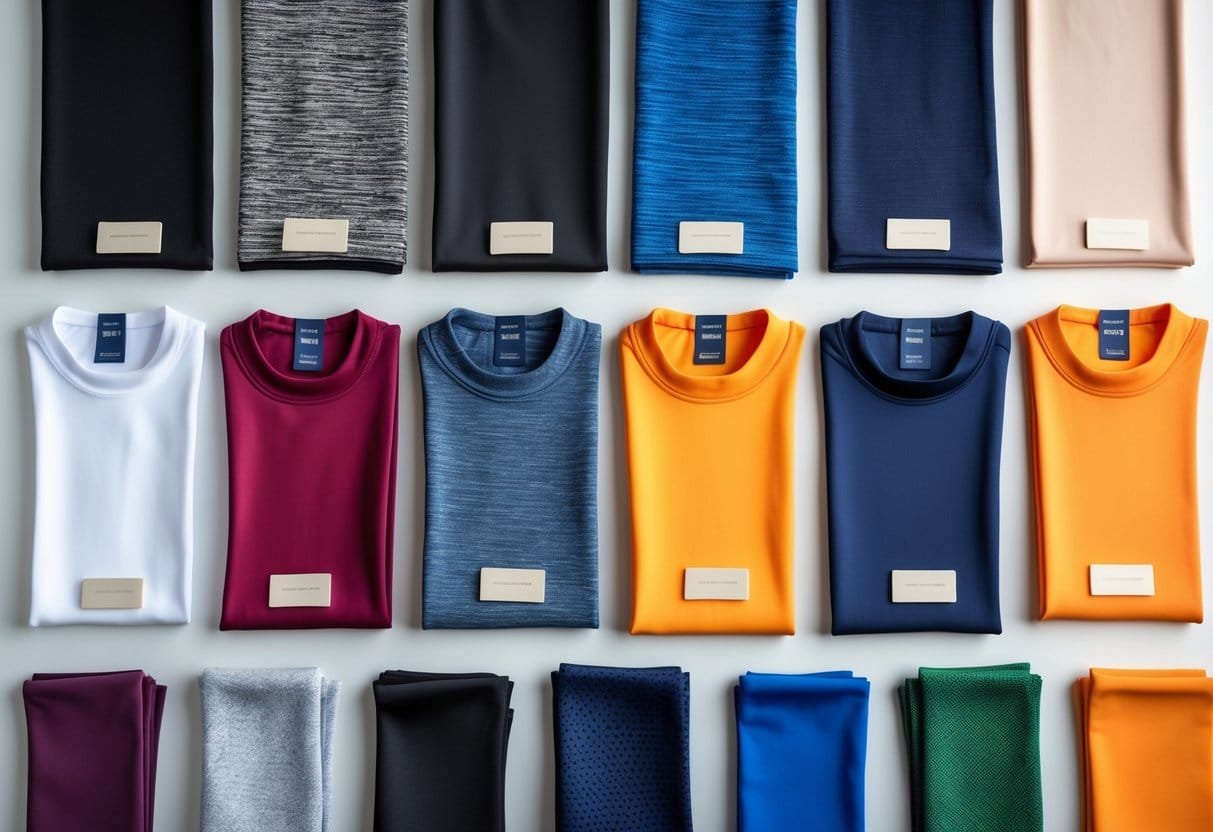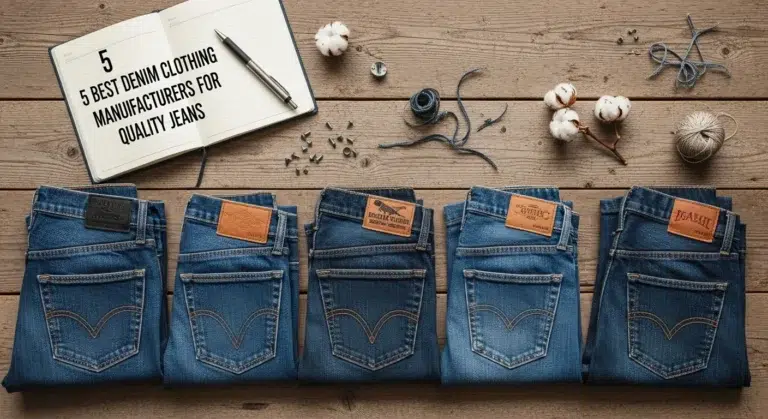12 Different Tracksuit Fabrics Everyone Must Know: The Ultimate Guide
Tracksuits are no longer just for exercise—they have become a key part of everyday style and comfort. Choosing the right fabric is crucial because it affects how the tracksuit feels, performs, and looks. Knowing the different types of tracksuit fabrics helps people pick the best one for their needs, whether for workouts, lounging, or making a fashion statement.

Fabrics like polyester, cotton fleece, nylon, and bamboo each bring unique benefits such as moisture-wicking, softness, durability, or eco-friendliness. Some materials focus on performance features, while others offer style and warmth. Understanding these fabrics allows individuals to find a tracksuit that matches their lifestyle and preferences.
This guide covers 12 essential tracksuit fabrics, highlighting their main qualities and uses. It also touches on newer, innovative materials that blend function with style, making it easier to choose a tracksuit that suits various activities and weather conditions.
Key Takeways
- Tracksuit fabrics vary in comfort, performance, and style features.
- Different materials serve specific needs like warmth, breathability, or stretch.
- New fabric options combine sustainability with durability and fashion.
Understanding Tracksuit Fabric Types

Choosing the right tracksuit fabric means knowing the materials involved and how they affect comfort and performance. Key factors include whether the fabric is natural or synthetic, and how it handles breathability, moisture, and durability. These details shape how tracksuits perform during workouts or daily wear.
Defining Tracksuit Fabric
Tracksuit fabric is the material used to make tracksuits, designed for both athletic activity and casual wear. It needs to balance comfort, stretch, and durability. Some fabrics focus on softness and warmth, while others prioritize technical features like moisture control and quick drying.
Fabric choices vary widely, from traditional cotton fleece to high-tech blends like polyester with spandex. Each fabric serves different purposes, such as running, lounging, or outdoor use. Understanding these distinctions helps users pick the best tracksuit for their lifestyle and activities.
Natural vs Synthetic Materials
Natural fabrics, like cotton and bamboo, are known for softness and breathability. They feel comfortable against the skin but tend to absorb moisture rather than wick it away. Natural fibers are usually better for casual wear or light activities but can take longer to dry.
Synthetic fabrics, such as polyester, nylon, and spandex blends, are made from man-made fibers. They usually offer better durability, are lighter, and dry faster. These materials often include moisture-wicking properties, helping to keep the wearer dry during workouts. Synthetic fabrics are also more resistant to shrinking and wrinkling.
Choosing between natural and synthetic depends on how the tracksuit will be used. Many modern tracksuits combine both to balance comfort with performance.
Key Fabric Attributes: Breathability, Durability, and Moisture-Wicking
Breathability is the ability of fabric to let air pass through, which keeps the wearer cool and reduces sweat buildup. Fabrics like mesh and cotton excel in breathability, making them good for warm weather and light exercise.
Durability refers to the fabric’s resistance to wear, tear, and repeated washing. Polyester and nylon ranks high here, maintaining shape and color over time. Natural fibers tend to wear faster and may shrink or fade with use.
Moisture-wicking fabrics pull sweat away from the skin to the surface where it evaporates. This helps athletes stay dry and comfortable during intense activity. Polyester blends and bamboo fiber often include this feature, making them popular choices for sportswear.
| Attribute | Best Fabrics | Purpose |
|---|---|---|
| Breathability | Mesh, cotton, bamboo | Cooling, light exercise |
| Durability | Polyester, nylon, spandex | Long-lasting wear |
| Moisture-Wicking | Polyester blends, bamboo | Sweat management during workouts |
The 12 Essential Tracksuit Fabrics

Tracksuit fabrics need to balance comfort, durability, and performance. Each material offers different benefits like moisture-wicking, stretch, or warmth. The right fabric depends on activity level, weather, and personal preference.
Polyester
Polyester tracksuit fabric is one of the most common choices for fitness clothing. It is lightweight and strong, which helps garments keep their shape after many workouts and washes.
Polyester also wicks moisture away from the skin, keeping the wearer dry and comfortable. It dries quickly, making it ideal for intense workouts or outdoor activities. It resists shrinking and wrinkling, which makes maintenance simple.
This fabric often comes in smooth or brushed textures, providing options depending on the style and feel preferred. Because of its durability and easy care, polyester is widely used in sportswear and activewear brands.
Nylon
Nylon tracksuit fabric stands out for being durable and lightweight. It offers excellent stretch, which allows full freedom of movement during exercise. This makes it a great choice for activities involving bending or stretching.
Nylon dries fast and is water-resistant, repelling light rain and sweat. Its abrasion resistance also helps it last longer, especially outdoors. This fabric is often preferred in tracksuits designed for running or high-intensity sports.
Due to its strength and flexibility, nylon tracksuits maintain their fit well. It is a good option for those who want a fabric that can handle frequent wear and rough conditions.
Spandex
Spandex is known for its exceptional elasticity and comfort. It is often blended with other fabrics to improve their flexibility. This quality is essential in tracksuits made for dynamic movement and stretching.
Spandex is lightweight and breathable, helping prevent overheating during workouts. It also dries quickly, so sweat won’t feel heavy or sticky on the skin.
Due to its stretch, spandex helps tracksuits fit closely without restricting movement. It is especially common in tracksuits designed for activities like yoga, dance, or any sport requiring high flexibility.
Cotton
Cotton is favored for its softness and breathability. It absorbs moisture but can take longer to dry compared to synthetic fabrics. Cotton tracksuits often feel comfortable for casual wear or light activity.
Cotton is durable and easy to care for. It is available in various thicknesses, so wearers can choose lightweight options for warmer days or heavier ones for cooler weather.
While cotton doesn’t wick moisture as well as polyester or nylon, its natural fibers provide a cozy feel. This makes cotton tracksuits a good choice for lounging or low-impact sports.
Advanced and Specialized Tracksuit Materials

These materials offer unique features that improve comfort and performance. They provide benefits like moisture management, temperature control, and durability. Each fabric suits different climates and activity levels, making them important choices for specialized tracksuits.
Tencel
Tencel is a fiber made from wood pulp, known for its smooth, soft texture. It naturally wicks moisture away from the skin, helping to keep the wearer dry and comfortable during exercise.
This material is wrinkle-resistant and breathable, making it a good option for those who want low-maintenance activewear. Tencel is also biodegradable, appealing to people who prefer eco-friendly clothing.
Its cooling properties suit warmer weather or indoor workouts. Tencel blends well with other fabrics to enhance softness and performance without adding weight or bulk.
Bamboo Fiber
Bamboo fiber is lightweight and has natural moisture-wicking abilities. It pulls sweat away from the body, which helps reduce discomfort during physical activity.
This fabric is also odor-resistant, which limits the buildup of bacteria. That makes bamboo fiber tracksuits a good choice for extended wear or outdoor use.
Bamboo fiber gives some protection against UV rays, making it useful for outdoor sports. It is soft to the touch and sustainable, as bamboo grows quickly and requires little water.
Wool
Wool is a strong thermal insulator that retains heat well, even when damp. This makes wool tracksuits ideal for cold weather conditions.
The fabric is breathable, allowing excess moisture to escape, which helps prevent overheating despite its warmth. Wool also resists odor buildup, so it stays fresher longer during workouts.
Wool’s natural elasticity allows decent flexibility, but it is heavier than synthetic options. People often choose wool when they need warmth combined with breathability in outdoor or winter activities.
Polypropylene
Polypropylene is a synthetic plastic-based fabric known for being completely water-resistant. Unlike other materials, it keeps the inside dry even if sweat collects on the surface.
It is lightweight and resists stains, making it tough for heavy use. Polypropylene also insulates well and dries quickly, helping regulate body temperature.
Due to its water resistance, this fabric is often used as a base layer or alone in rainy or wet conditions. It allows for good mobility without restricting movement.
Innovative and Trending Tracksuit Fabrrics

Certain fabrics have gained attention not only for comfort but for technical features and style trends. These materials combine function with fashion, appealing to those who want both performance and a modern look in their tracksuits.
Fleece
Fleece is valued for its warmth and softness, making it a strong choice for cooler weather tracksuits. Its brushed surface traps heat, providing insulation without adding bulk.
A fleece tracksuit often uses synthetic fibers like polyester, which wick moisture to keep the wearer dry. This fabric suits casual wear and light exercise, thanks to its breathability and stretch.
It is lightweight, easy to care for, and retains warmth even when damp. This makes fleece popular in athleisure, balancing comfort with everyday style.
Gore-Tex
Gore-Tex is a high-performance fabric known for its waterproof and windproof properties while remaining breathable. It protects athletes from rain and harsh weather during outdoor activities.
In tracksuits, Gore-Tex layers keep the wearer dry without trapping sweat. This is important for comfort during long workouts or harsh conditions.
The fabric’s membrane blocks water but allows vapor to escape. Its durability and protective quality make it ideal for outdoor sportswear and fashion-forward activewear.
Velour
Velour offers a plush, velvet-like texture that sets it apart from other tracksuit fabrics. It has a soft pile surface that gives depth to its colors and a luxurious feel.
This fabric is popular in athleisure and streetwear for those wanting style with comfort. Velour tracksuits blend cotton and polyester to balance softness with easier care.
While not suited for heavy physical activity, velour makes a statement in casual and fashionable settings. It matches well with current trends emphasizing comfort and style.
Scuba
Scuba fabric is a smooth, thick knit made from synthetic fibers, often neoprene blends. It holds shape well and provides a structured silhouette, popular in modern athleisure designs.
Its stretch and resistance to wrinkles make it good for stylish tracksuits that maintain form during movement. The fabric is lightweight but offers some insulation.
Scuba is water-resistant and durable, often chosen for fashion-forward sportswear rather than intense performance. It creates bold, clean looks in contemporary tracksuit styles.
Performance Features and Customization in Tracksuit Fabrics

Tracksuit fabrics often combine key qualities to boost comfort and fit. These include fine microfiber blends for softness and durability, fabrics with stretch for ease of movement, and moisture-wicking technology that keeps athletes dry. Custom tracksuits use these features to meet specific style and performance needs.
Microfiber and Jersey
Microfiber is a very fine synthetic fiber known for its softness and strength. It creates fabric that feels smooth on the skin and resists wear over time. Tracksuits with microfiber blends offer lightweight comfort, making them suitable for both active use and casual wear.
Jersey fabric, often made with cotton or polyester blends, adds stretch and breathability. It drapes well and moves with the body, which makes it ideal for custom tracksuit designs that require flexibility. The soft texture of jersey increases comfort during long wear, while microfiber enhances durability.
Together, microfiber and jersey materials help create stylish and functional warmups that cater to both fashion and performance. They work well in various tracksuit styles, balancing comfort with a sleek look.
Elasticity and Stretch
Elasticity is vital in tracksuit fabrics for allowing a full range of motion. Materials often include spandex or elastane blended with polyester or nylon to create stretchy fabric. This gives wearers the ability to move freely without the fabric losing shape.
High stretch fabrics also improve fit, especially in customized tracksuits tailored to body measurements. The stretch helps prevent sagging or bagging after repeated use. It supports muscle movement and recovery by offering gentle compression in some custom warmup styles.
Choosing fabrics with good elasticity ensures that tracksuits remain comfortable and functional for sports, workouts, or casual wear. This is particularly important for athletes who need unrestricted motion and durability.
Moisture-Wicking Technology
Moisture-wicking fabrics pull sweat away from the skin to the outer surface of the fabric, where it evaporates quickly. Polyester and nylon microfiber blends are common for this feature, making them popular in performance tracksuits.
This technology keeps wearers dry and cool during intense activities, reducing discomfort from damp clothes. Many custom tracksuit manufacturers use moisture-wicking fabrics combined with mesh panels to boost ventilation in key areas.
Moisture management is often paired with quick-drying properties, which adds to comfort during workouts. It is essential for anyone looking for tracksuits that enhance performance by managing sweat effectively.
Choosing the Right Tracksuit Fabric for Your Needs

Selecting the right fabric depends on several clear factors. The fit and feel for the wearer, how the fabric performs in different weather, and how easy it is to care for all shape the overall experience. These practical points matter for athletes, casual users, and those building a tracksuit line.
Climate and Activity Considerations
The fabric choice should match the climate where the tracksuit will be worn and the activity type. For warm environments, lightweight and breathable fabrics like polyester or mesh help wick moisture and keep the athlete cool.
In cooler climates, thicker fabrics such as cotton fleece or tech fleece provide warmth while remaining comfortable. Outdoor runners or sports players benefit from nylon tracksuits that resist wind and water, protecting them during varied weather conditions.
Activity level also impacts fabric choice. High-intensity sports need fabrics that stretch and move well, like spandex blends. For casual or lounge wear, comfort and softness in materials like velour or bamboo fiber might take priority.
Comfort and Fit
Comfort depends on fabric smoothness, breathability, and stretch. Fabrics like cotton fleece and bamboo fiber are soft and gentle on the skin, making them popular for casual sportswear and loungewear collections.
Stretch fabrics such as spandex blends help retain shape and allow freedom of movement, key for fit in performance wear. Jersey knit offers a relaxed drape with moderate stretch, ideal for casual outfits and travel wear.
Custom tracksuit manufacturers focus on blends to balance comfort and durability. Fit varies by fabric weight and elasticity. It’s important for brands to consider how each material will feel after washing and prolonged use.
Maintenance and Durability
Durability is vital for sportswear and activewear brands aiming to build lasting products. Polyester and recycled polyester are strong, resist shrinking, and dry quickly. They handle repeated washing without losing color or shape.
Natural fabrics like cotton fleece or bamboo require gentler care, can absorb moisture, and may wear faster with heavy use. Velour and French terry fall in the middle, combining a nice hand feel with reasonable durability.
Maintenance convenience affects customer satisfaction. Easy-care fabrics that resist wrinkles and dry fast reduce hassle for wearers. For new fitness clothing lines, choosing low-maintenance fabrics can decrease returns and improve long-term brand reputation.
Influence of Tracksuit Fabrics on Fashion and Sports

Tracksuit fabrics impact both style and athletic performance. The choice of materials shapes how tracksuits look, feel, and function. These fabrics also play a key role in major sports events and brand collaborations that influence broader fashion trends.
Iconic Clothing Brands and Collaborations
Brands like adidas, Juicy Couture, and Ralph Lauren have made tracksuits a major fashion item by using distinct fabrics and designs. Adidas blends polyester and spandex to create durable, moisture-wicking sportswear. Juicy Couture popularized velour tracksuits, making plush fabrics a symbol of luxury loungewear.
Collaborations have boosted tracksuit status. For example, Stella McCartney’s designs with Adidas introduced high-performance, eco-friendly fabrics, combining style with function. These partnerships often use innovative materials like tech fleece or recycled polyester, drawing attention to sustainability and modern style.
Tracksuits in Olympic History
The 2010 Winter Olympics and the 2012 GB Olympic Games showcased how fabric choices affect both athlete performance and national image. Tracksuits made from lightweight nylon and polyester blends offered durability and weather resistance for outdoor events.
These materials ensured athletes stayed warm and flexible while maintaining a sleek look. National teams often choose fabrics with moisture-wicking and quick-drying features to keep competitors comfortable. The visibility of these tracksuits during ceremonies also influenced global sports fashion by highlighting the merge of technology and design.
Rise of Athleisure
The athleisure trend transformed tracksuits from workout clothes into everyday fashion staples. Fabrics like cotton fleece, French terry, and bamboo blends combine softness and breathability, making tracksuits fit for casual wear and relaxation.
This trend favors comfort without sacrificing style. Lightweight polyester and spandex blends support movement, while sustainable materials like recycled polyester appeal to eco-conscious consumers. Athleisure’s growth has pushed brands to innovate fabric choices, reflecting changes in how people dress on and off the field.
Frequently Asked Questions
Tracksuit fabrics vary greatly in breathability, flexibility, durability, eco-friendliness, and suitability for different weather conditions. Proper fabric choice also influences how easy the tracksuit is to care for. These factors affect performance and comfort during use.
What are the best fabrics for breathability in tracksuits?
Cotton is highly breathable and soft, making it good for moderate activities. Polyester and nylon fabrics are engineered to wick moisture and allow airflow, keeping the wearer dry during intense workouts. Tencel also offers excellent breathability and feels cool on the skin.
Which tracksuit materials offer the most flexibility for athletic activities?
Spandex provides great stretch and flexibility. It is often blended with polyester or nylon to create tracksuits that allow easy movement. Nylon alone is also elastic and durable, suitable for activities requiring a wide range of motion.
How do differences in tracksuit fabrics affect durability and longevity?
Polyester and nylon are strong and resist shrinking, wrinkling, and fading. Cotton is durable but can wear out faster when subjected to heavy exercise or frequent washing. Synthetic blends with spandex tend to maintain shape longer and dry quickly, increasing lifespan.
Can you recommend eco-friendly fabric options for tracksuits?
Bamboo fiber and Tencel are natural, biodegradable materials that are gentle on the environment. Bamboo offers UV protection and moisture-wicking properties, while Tencel maintains softness and durability. Choosing these supports sustainable fashion.
What tracksuit materials are optimal for cold weather workouts?
Wool and fleece are the best for warmth. Wool traps heat while allowing breathability without odor buildup. Fleece made from synthetic fibers provides insulation, moisture resistance, and a lightweight feel for outdoor activities in cold conditions.
How do fabric choices impact the maintenance and care of tracksuits?
Polyester and nylon require simple care, as they dry fast and resist wrinkles. Cotton absorbs moisture and may take longer to dry, requiring more washing care to avoid shrinkage. Blended fabrics balance care needs by combining easy maintenance with comfort.







